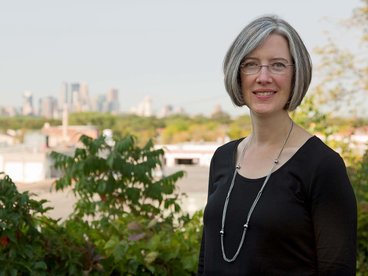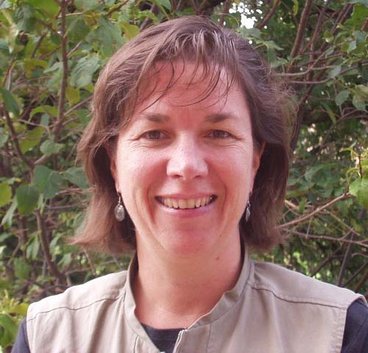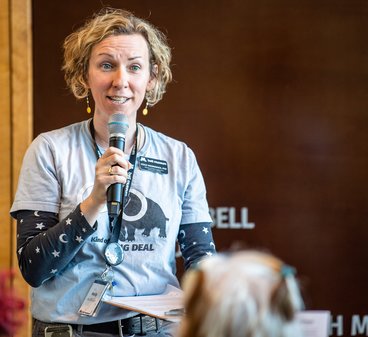
CFANS engages with University and other partners on long-term urban nature research, outreach
Projects kick off with an inherently collaborative approach, aim to continue building community connection

Announced in March of this year, the Minneapolis-St. Paul Metropolitan Area Urban Long Term Ecological Research (LTER) program will be a collaboration across the University of Minnesota, the University of St. Thomas, the U.S. Forest Service, The Nature Conservancy, and Water Bar. Among the nine initial projects in this program, CFANS faculty and staff will be leading or co-leading five.
Urban nature, such as streams and urban forests, provides a number of benefits from flood relief to helping cities adapt to heat waves. However, urban nature continues to be under stressors caused by a number of factors, including climate change, invasive pests, pollutants, and habitat loss and fragmentation.
CFANS-led projects feature work that ranges from soil mapping and watershed modeling to environmental policy advocacy, community-engaged research and hands-on science learning. Explore each project and gain insights directly from project leads below.
Ecological Impacts of Urban Contaminants
Toxins—heavy metals and salts, for example—are elevated in cities because of human activities such as past use of lead paint and gasoline, winter road salt application, and use of building materials. However, these toxins are not found in the same amounts across neighborhoods. Furthermore, not all living creatures seem to be harmed equally by these toxins.
Soil, Water and Climate Assistant Professor Nic Jelinski, PhD, and Associate Professor Emilie Snell-Rood, PhD, of the College of Biological Sciences will map heavy metals in soils across the Twin Cities in this project to discover where pollution levels are highest, as well as explore why some species of plants and animals thrive in polluted environments, and whether we can find ways to manage ecological communities to reduce the risk of exposure.
“This work first and foremost involves self-reflection and an understanding of where our personal backgrounds and professional activities fit in the broader Twin Cities community. Building solid relationships takes time, effort, and consistency, and as an important mentor of mine often says, ‘change moves at the speed of trust,’” Jelinski said. “Rather than approaching urban systems purely as objects of study, we must instead use the opportunity afforded by the LTER to generate deep and lasting relationships, to highlight the excellent work that so many individuals and organizations in our communities are already doing, and to ask how the research and science that we do in the context of this work can lead to a healthier, stronger and more equitable urban environment for everyone.”
Functioning of Urban Watersheds
Urban watersheds can reduce flooding by rapidly moving water downstream or providing locations where water can soak into the ground and can cool neighborhoods through shading and evaporation. However, the capacity for urban watersheds to provide benefits to urban residents depends in part on the arrangement of a complex patchwork of “green” (natural), semi-natural and “grey” (built) infrastructure, as well as where these patches are placed and how they are connected.
To better understand how urban watersheds function, Soil, Water and Climate Associate Professor Tracy Twine, PhD, and Assistant Professor Xue Feng, PhD, of the College of Sciences and Engineering will collect data on the flow of water through urban watersheds and how that flow depends on the nature of this complex patchwork.
“I’m interested in the urban heat island effect and how water moves between the land and atmosphere. I see my work intersecting with other projects through the study of water at various scales, as well as how heat impacts diverse populations of urban residents” Twine said. “It’s important to overlap an understanding of demographics with where relatively hotter and cooler neighborhoods are located.”
They will use computer models and tools to help identify tradeoffs between the benefits and burdens that urban watersheds provide to urban residents, and how they change under land management and climate scenarios. “Physical scientists like myself have characterized urban neighborhoods as hotter or cooler, and there is clear evidence that hotter neighborhoods are correlated with race, economic, education, and age demographics,” Twine said. “It’s important for physical scientists to collaborate with social scientists to understand how these disparities arose, how these relationships affect populations currently, and how they might be addressed moving forward.”
Advocacy in Environmental Policies and Practices
Although much is known about policies and practices that might protect the environment, the effectiveness of these policies and why some communities adopt them while others do not is unclear. The Twin Cities has numerous local governments, many of which have adopted innovative environmental policies and practices.
Forest Resources Assistant Professor Forrest Fleischman, PhD, and Professor Kristen Nelson, PhD, of Forest Resources and Fisheries, Wildlife and Conservation Biology will study how people advocate for improved environmental outcomes, helping to identify effective strategies. “The high quality of life in the Twin Cities is partially a product of the urban nature that surrounds us—we recreate in parks and backyards, enjoy traveling on tree-lined streets, and benefit from the ways that urban forests shade our homes and moderate temperature extremes,” Fleishman said. “A better understanding of how urban nature works, and how human decisions influence it, can help us to make urban nature an even greater contributor to our well-being.”
They are particularly interested in understanding the continued disparities in environmental quality based on race and class in the Twin Cities—their history, as well as the advocacy strategies that can overcome them. “Co-creation of knowledge will happen in so many ways. We are particularly interested in understanding effective advocacy strategies that can overcome historical disparities in environmental quality and provide long-term insights about how, when and why change occurs,” Nelson said. “There is so much we can learn in a long-term study—variations, timing, drivers of change, unexplored relationships among people, the built environment and urban nature.”
Impacts of Inclusive, Community-Engaged Research
Past research with community partners in the Twin Cities has privileged those in positions of power. Forest Resources Professor Mae Davenport, PhD, and Lead Artist and Collaborative Director Shanai Matteson at Water Bar plan to engage with, listen to, and learn with Black, Indigenous, and People of Color (BIPOC) communities towards acknowledging and addressing systemic racism and legacies of discriminatory practices in urban ecosystem science, policy, and management.
“This project aims to support the science and community engagement of the other projects. Our work will be cross-cutting and community-driven,” Davenport said. “The strength of this long-term ecological research program is that from the start we acknowledge different ways of knowing urban nature. We recognize that so many critical voices to understanding personal, social, and cultural relationships to urban nature for too long have been silenced or ignored.”
They will examine how conducting inclusive research changes how research is done and its impact on researchers themselves over the long term, to create more equitable long-term urban nature research outcomes. “I am thrilled to learn from our existing and newly developing community partners about their relationships to urban nature, and I look forward to supporting the great work so many community organizations are doing already and weaving together the diverse talents of our UMN team and our Twin Cities community partners,” Davenport said. “What an amazing opportunity to show the nation how we can come together across ways of knowing and doing to protect and restore urban nature.”
Schoolyard Long-Term Ecological Research (LTER) Program at the Bell Museum
Middle school learners from urban schools lack opportunities for experiential learning about Earth and life sciences. The Bell Museum, led by Director of Public Engagement and Science Learning Holly Menninger, PhD, will provide middle school learners from the Twin Cities with field trip experiences to the Bell, which features exhibits, a planetarium, a learning landscape with extensive pollinator habitat, a stormwater pond, and rain gardens, and an institutional commitment to racial and social justice.
“The Bell Museum is so excited to be part of the new MSP LTER. We have an awesome opportunity to support middle school students and teachers in exploring and understanding the ecology right in their own schoolyards, neighborhoods and backyards,” Menninger said. “We look forward to co-creating lessons that bring research on insect pollinators, water quality, and forest cover—all areas of great research expertise at the U—to life for students across the Twin Cities. We want to spark students' curiosity and wonder, and help them to understand the interconnection between people and nature, particularly in cities.”
The Bell will work with teachers to develop resources for using urban nature in their own school yards and neighborhoods to engage with students about science in ways that meet state science standards. “This work builds on the Bell Museum's commitment to supporting K-12 STEM education in socially and culturally relevant ways,” Menninger said. “We're thrilled about the opportunity to use the Bell 's Learning Landscape—featuring extensive pollinator habitat and rain gardens— as an outdoor laboratory for student field trips.”
Four other collaborative projects will be happening as part of this work, supported by other UMN units and key partner groups. Read the original press release.










